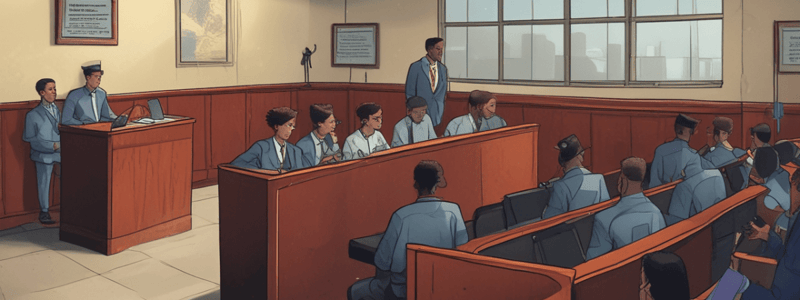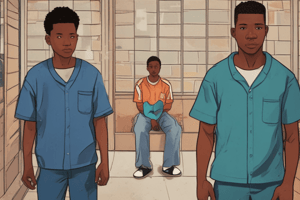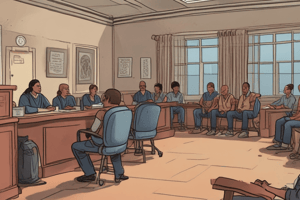Podcast
Questions and Answers
True or false:The juvenile justice system focuses primarily on rehabilitation rather than punishment.
True or false:The juvenile justice system focuses primarily on rehabilitation rather than punishment.
False (B)
True or false: Status offenses are only considered violations if committed by someone under the age of 18.
True or false: Status offenses are only considered violations if committed by someone under the age of 18.
True (A)
True or false: Deinstitutionalization mandates that youth offenders must always be given alternative forms of punishment, such as community service or probation, instead of detention or placement in a secure facility.
True or false: Deinstitutionalization mandates that youth offenders must always be given alternative forms of punishment, such as community service or probation, instead of detention or placement in a secure facility.
False (B)
True or false: The Juvenile Justice and Delinquency Prevention Act provides federal funding to states that follow federal protections for youth in the justice system.
True or false: The Juvenile Justice and Delinquency Prevention Act provides federal funding to states that follow federal protections for youth in the justice system.
True or false: Miranda warnings are only required for adults who are being questioned by law enforcement officers.
True or false: Miranda warnings are only required for adults who are being questioned by law enforcement officers.
True or false: All states require the presence of a parent or guardian during questioning of a juvenile by law enforcement.
True or false: All states require the presence of a parent or guardian during questioning of a juvenile by law enforcement.
True or false: The American Bar Association encourages juveniles to plead guilty in order to receive a lesser sentence.
True or false: The American Bar Association encourages juveniles to plead guilty in order to receive a lesser sentence.
True or false: Child Protective Services (CPS) agencies receive reports of suspected abuse and neglect and screen them for further investigation.
True or false: Child Protective Services (CPS) agencies receive reports of suspected abuse and neglect and screen them for further investigation.
True or false: If CPS determines that the findings of abuse or neglect are substantiated, a juvenile court action is always filed.
True or false: If CPS determines that the findings of abuse or neglect are substantiated, a juvenile court action is always filed.
True or false: Most families of children who are removed from their homes receive services to reduce the risk of maltreatment in the future and to reunite with the child.
True or false: Most families of children who are removed from their homes receive services to reduce the risk of maltreatment in the future and to reunite with the child.
True or false: The federal government is responsible for managing the child welfare system in each state.
True or false: The federal government is responsible for managing the child welfare system in each state.
True or false: The US Supreme Court has ruled that prohibiting the publication of a legally obtained name or photograph of a youth offender involved in juvenile court proceedings is constitutional.
True or false: The US Supreme Court has ruled that prohibiting the publication of a legally obtained name or photograph of a youth offender involved in juvenile court proceedings is constitutional.
Flashcards are hidden until you start studying
Study Notes
- The juvenile justice system emphasizes offender accountability, punishment, deterrence, and community protection.
- Juvenile courts have jurisdiction over cases involving delinquency committed by those younger than 18 at the time of the offense.
- Delinquency refers to acts committed by juveniles that would be considered a crime if committed by an adult.
- Status offenses are violations only when committed by a person younger than 18 due to their status as a juvenile.
- The handling of status offenders differs from delinquent offenders in the juvenile justice system.
- The Juvenile Justice and Delinquency Prevention Act provides funds to states that follow federal protections for youth in the justice system.
- The Office of Juvenile Justice and Delinquency Prevention funds juvenile justice programming and directs federal initiatives.
- Deinstitutionalization mandates that the liberty of youth offenders not be taken away through detention or placement in a secure facility if they did not commit a crime.
- Sight and sound separation mandates that juvenile offenders be separated from adult offenders when being detained.
- The system aims to reduce disproportionate minority youth involvement at every stage of the juvenile justice system.
- C TIM reviews offender's court record and decides referral to juvenile court or diversion programs.
- More than two-thirds of cases are referred to juvenile court.
- Alternative to apprehensions or referral to juvenile court include questioning and warning, issuing a citation, or referral to a diversion program or service.
- Temporary detention of a juvenile is required for no more than six hours while contacting parents or arranging transportation to a juvenile detention facility.
- Law enforcement officers are required to give a Miranda warning before questioning an individual in a criminal case.
- Juveniles who are questioned by law enforcement officers at school should be given a proper Miranda warning before being questioned.
- Juveniles can waive Miranda rights, but the prosecution must establish that the juvenile understood their rights and waived them freely before being questioned.
- Only a few states require the presence of a parent or guardian during questioning of a juvenile by law enforcement.
- Many states require that a parent or guardian be notified.
- Wrongful conviction among youthful offenders is often caused by interrogation and confession.
- Juvenile courts have separate adjudicatory and dispositional hearings.
- Juveniles may not have the right to a jury trial in some states.
- Legal competency requires understanding of charges and possible penalties.
- Juvenile court focuses on individualized intervention programs for rehabilitation.
- Mandatory sentences ensure consistent punishment for the same offense.
- Disposition options include warning, restitution, community service, probation, and confinement.
- Juvenile court proceedings and records have shifted towards openness and accountability.
- The American Bar Association discourages juveniles from pleading guilty due to collateral consequences.
- Probation officers prepare disposition plans based on assessments of the juvenile and available programs.
- Competency is necessary for a fair trial, and mental health issues may render a defendant incompetent.
- The US Supreme Court ruled in 1977 that prohibiting the publication of a legally obtained name or photograph of a youth offender involved in juvenile court proceedings is unconstitutional.
- The Child Welfare System involves various auxiliary systems unique to children, including child protective services, schools, and behavioral health providers.
- The federal government focuses on ensuring the safety of children from maltreatment, protecting and promoting stable and permanent family relationships, and caring for the well-being of maltreated children.
- Each state manages its own child welfare system, which varies from state to state and includes both public and private services and programs.
- CPS agencies receive reports of suspected abuse and neglect and screen them for further investigation.
- If CPS determines that the findings of abuse or neglect are substantiated, a juvenile court action is filed.
- Most families of children who are removed receive services to reduce the risk of maltreatment in the future and to reunite with the child, which is usually part of the permanency plan for child maltreatment cases.
Studying That Suits You
Use AI to generate personalized quizzes and flashcards to suit your learning preferences.




